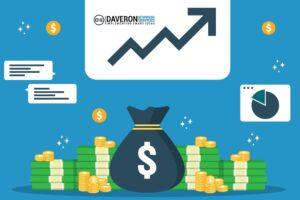Every business needs to be prepared for the future. You need to be able to adapt and change according to possible fluctuations and events that might affect your business. In order to plan for future events, you need to forecast what might happen.
Financial forecasting can help you do that. You want to maximize your current resources. You also want to optimize profitability and growth in the future, and minimize waste. A financial forecast takes the guesswork out of the procedure, and gives projections derived from business, industry, and economic data.
Clarify Your Definition of Forecasting
A financial forecast is a document that measures and plans for future business results. It gives precise detail about projections for income, expenditure and significant operational decisions. It even takes into account operational KPIs.
Be careful not to confuse financial forecasting with budgeting. Budgeting refers to specific amounts of money, but is only one section of financial forecasting.
A financial forecast includes, and will help you determine:
- – Your projected earnings and when they will occur.
- – Expenses such as labor costs, sales, marketing, expenditure on property and equipment, materials, research and development and insurance.
- – Cash flow at any point in time.
- – When to hire new employees and their salaries.
- – When to increase or decrease prices.
- – What products are promoted and when.
- – When to add new products and how to support them.
- – How to develop sales strategies.
- – How much inventory you require, and when.
- – When to boost capital, the amount you’ll require, and from which sources
- – Plan for depreciation and replacement of equipment.
- – The best time to expand geographically, and how to maintain that growth.
First Build a Solid Business Model
Without a solid business model, you can’t have good financial forecasting. Part of the business model is the revenue model. A good revenue model will be able to answer the following questions:
- – In order to grow by 25%, what investments are necessary?
- – If revenue is not growing, what can we cut to increase profits?
This enables you to imagine any kind of scenario and examine assumptions. This, in turn, may help you to find unknown sources of revenue.
Start with the relationships between price and volume. This is the essence of most businesses, even when definitions and formulas differ.
Do a top-down and a bottom-up model. Top-down models start with a broader picture of what is happening in the market, and a bottom-up model focuses on the operational details of your business. Being aware of both enables you to identify gaps in your capacity, and transform them into something positive.
Create a Model for Your Expenses
It is important to have a model for your revenue, both incoming and outgoing. You need to include the following:
- 1. Personnel: You either do a headcount or an hourly rate, depending on the type of business and goods you sell.
- 2. Operating Expenses: This is often very closely connected with headcount.
- 3. Fixed versus variable costs: you need to model the fixed and variable costs differently. The fixed costs don’t change very much, but the variable costs, like packaging or raw materials, might fluctuate. This means that you would need a formula, or percentage of total revenue to be taken into account.
- 4. Cost Centers: You may wish to spread your costs across your departments, or cost centers, proportioning your budget and forecast according to goals, priorities and requirements. So, for instance, IT can be spread across all your cost centers, rather than being an item on its own. This will help you ascertain the full cost of each department. You would either do this per head, or per square foot.
Set a Rhythm
It is vital to set the rhythm of your business and connect it to your calendar. You’ll be redefining your financial forecast over time, rather than having it set in stone. So, you first plan and budget then get quarterly and monthly forecasts from all stakeholders. This means that you’re constantly re-evaluating and adapting.
Forecast the Important Aspects of Your Business
You don’t just forecast the financial aspects of your company, but also the operational assumptions. Consider the following aspects:
- 1. How long will it take to reach a particular goal?
- 2. How many units will you sell in a specified amount of time?
- 3. What increase in customers do you expect each month?
- 4. How long is each sales cycle?
- 5. When will customers be billed? Quarterly, monthly, weekly?
- 6. How long will it take to receive payment from customers? Days, months?
- 7. What amount of money will your company spend per month before it starts to make a profit?
- 8. By how much (%) will your expenses decrease or increase per year?
- 9. By how many people do you expect your company to grow?
Those are simply examples of assumptions, but they’re important to articulate and clarify. Not only will they help you, but they will also assist any potential investor, should they wish to partner with you.
Set Up Clear Reporting Processes
You need to set up the reports that you require in order to understand the state of your business. The reports must be very simple and clear. They must include financial reviews, performance of KPIs and other data you can share with your team.
The process of creating a report is just as important as the report itself. Automation is key—it simplifies the task and reduces the hassle and stress of collating data.
Select the Right Financial Forecasting Tools
In order to do this, you’ll need the right forecasting tools. Excel is good, but cloud-based services will allow for collaboration and reconciliation between staff on a bigger scale.
Conclusion
Financial forecasting is about understanding your company’s operations in the context of the economy at large. It is also about understanding what the risks and opportunities are in this environment. In addition, it is about communicating all this to your key partners.
Struggling to do your own financial forecasting? Daveron Networking has the expertise you need to develop a financial forecast that will take your planning to the next level.
Ready to grow your business? Speak to our growth experts and learn how to expand your customer base, drive revenue growth, and optimize your business operations.




